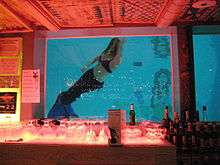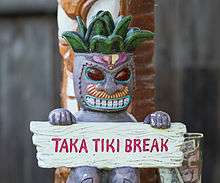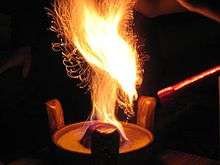Tiki bar
A tiki bar is an exotic-themed drinking establishment that serves elaborate cocktails, especially rum-based mixed drinks such as the mai tai and zombie cocktail. Tiki bars are aesthetically defined by their tiki culture décor which is based upon a romanticized conception of tropical cultures, most commonly Polynesian.
The interiors and exteriors of tiki bars often include "tiki god" masks and carvings, grasscloth, tapa cloth and tropical fabrics, torches, woven fish traps, and glass floats, bamboo, plants, lava stone, hula girl, palm tree motifs, tropical murals and other South Pacific-themed decorations. Indoor fountains, waterfalls or even lagoons are popular features. Some tiki bars also incorporate a stage for live entertainment such as exotica-style bands or Polynesian dance floor shows.
History



One of the earliest and best-known tiki bars was named "Don the Beachcomber", and was created in Los Angeles in 1933 by Ernest Gantt (aka "Donn Beach"). The bar served a wide variety of exotic rum drinks (including the popular "Sumatra Kula" and "Zombie cocktail") as well as Cantonese food, and displayed many artifacts that Gantt had collected on earlier trips through the tropics.[1] When Gantt was sent to World War II, Don the Beachcomber flourished under his ex-wife's management, expanding into a chain of 16 restaurants.[2]
When Gantt returned from the War, he moved to Hawaii and opened "Waikiki Beach", one of the two archetypal tiki bars. The bar was designed to evoke the South Pacific, with palm trees, tiki masks on the walls, a garden hose that showered a gentle rain on the roof and a myna bird that was trained to shout "Give me a beer, stupid!" The bar was located on the beach, lit by tiki torches outside which enhanced its primitive ambiance.[2]
The other archetypal bar is Trader Vic's, the first of which was created by Victor Bergeron in Oakland, California, in 1936. The quintessential tiki cocktail, the Mai Tai, was concocted at the original Trader Vic's in 1944.[3] Bergeron expanded the business to eventually include branches all over the world, as well as marketing cocktail mixes and other products for retail sale. Members of the Bergeron family still have a hand in the operations of at least one branch. The original Oakland location is gone, but there is still a Trader Vic's located a few miles away in Emeryville, California.
The Tonga Room of the Fairmont Hotel in San Francisco is an iconic tiki bar operating since 1945, and undergoing a number of facelifts over the years.[4] In 1962, the Sip 'n Dip Lounge opened in Great Falls, Montana, bringing a tiki theme to the landlocked, cold northern state, featuring a swimming pool where swimmers could be observed underwater from a window in the bar, a concept inspired by a similar design at the Playboy Club in Chicago.[5]
The original tiki bars flourished for about 30 years, and then fell out of vogue. In the 1990s, the Tiki culture was revived by a new generation of fans and new tiki bars were founded all over the world that often looked to Trader Vic's and Don the Beachcomber for inspiration.[6] In that decade, the Sip 'n Dip Lounge, which had survived with its tiki theme intact, added the feature of having women dressed as mermaids swimming in the pool within view of the bar's patrons.[7] As a result of the "mermaids" and the retro attractiveness of the tiki theme, in 2003, GQ Magazine rated the lounge as one of the top 10 bars in the world.[8]
Drinks

A hallmark of the tiki bar has always been specialty drinks, the recipes for which are often carefully guarded to prevent imitation by other bars.[2] Various kinds of rum, blue Curaçao and exotic syrups like orgeat are common ingredients, along with fresh tropical fruit juices and bitters.[2] Cocktails can be very complicated and dramatic, served in decorated ceramic vessels in the shapes of tikis (called "tiki mugs"), coconut shells or volcanoes among the more popular styles.[2] Cocktails are often garnished with paper cocktail umbrellas, live flowers or plastic animals. A scorpion bowl is a popular cocktail that is served in a ceramic bowl for communal drinking.[9] A variation on the scorpion bowl is the "volcano bowl." Also a communal drink, the volcano bowl drink is traditionally served in a ceramic bowl (similar to a scorpion bowl), but with a raised reservoir in the center, generally resembling a volcano. The reservoir is typically filled with 151 proof alcohol and lit on fire.
See also
- Bar (establishment)
- List of public house topics
- Tiki mugs
- Fassionola
- Exoticism
- Kava culture
- Tiki culture
References
- ↑ Robert Sharp & Nicole Weston (2015). Tiki Drinks: Tropical Cocktails for the Modern Bar. The Countryman Press. ISBN 9781581575965. Retrieved 10 December 2015.
- 1 2 3 4 5 Wayne Curtis (August 2006). "Tiki". American Heritage, Inc. Archived from the original on 15 October 2006. Retrieved 10 December 2015.
- ↑ "The History of the Tiki Bar". Tiki Bars.com. March 2009. Archived from the original on 5 March 2009. Retrieved 10 December 2015.
- ↑ Laura Borman (2015). Discovering Vintage San Francisco: A Guide to the City's Timeless Eateries, Bars, Shops & More. Rowman & Littlefield. pp. 184–189. ISBN 9781493014026. Retrieved 10 December 2015.
- ↑ Tori Bender (2014-02-15). "Tori Takes On Being a Mermaid At the Sip N Dip Lounge - KULR-8 Television, Billings, MT". Kulr8.com. Retrieved 2014-04-02.
- ↑ Mark Ehrman (March 2005), "Polynesian Review", Los Angeles Magazine, p. 32, retrieved 10 December 2015
- ↑ "Mermaids: Entertainers with a tail". CNN.com. Retrieved 2014-04-02.
- ↑ "MATR News: Quirky Sip-N-Dip (Great Falls) makes splash on GQ magazine's top 10 bars in the world". Matr.net. 2003-03-31. Retrieved 2014-04-02.
- ↑ Duggan McDonnell (2015). Drinking the Devil's Acre: A Love Letter from San Francisco and her Cocktails. Chronicle Books. pp. 94–97. ISBN 9781452140629. Retrieved 11 December 2015.
External links
| Wikimedia Commons has media related to Tiki bars. |
- The Bizarre Rise and Fall of the Tiki Bar
- [Historic Bars] Honolulu’s La Mariana Sailing Club Tiki Bar and Restaurant
- 6 Bars Ushering In Tiki’s Exciting 3rd Wave
